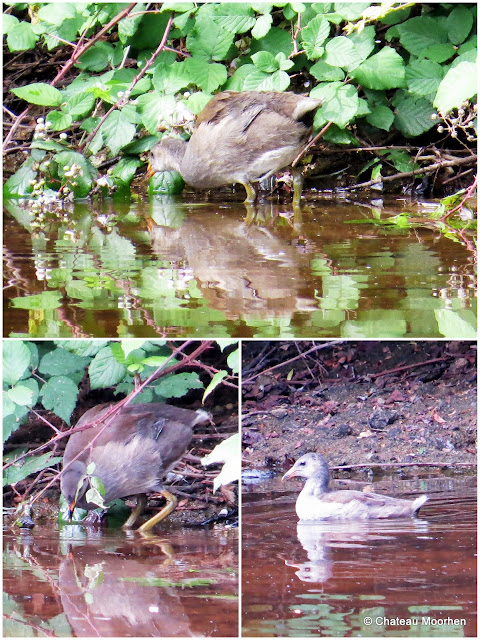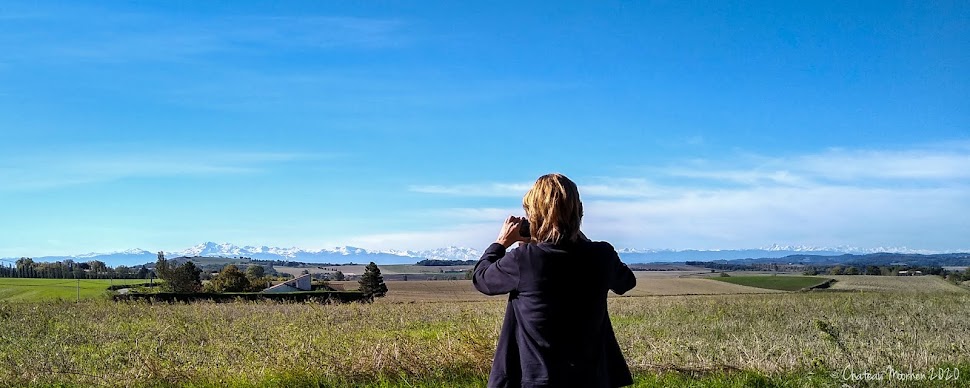Moorhen news:
It was 25th June when I noticed the two little pompoms and realised at least two baby moorhens had been born. A short time later I discovered one dead by the pond, so after that wasn't sure how many were left. Really it wasn't until the pond level dropped that we could start to see them in the shadows under the overhanging branches, on the rocks and mud by the side of the pond. There were still two so I think there had only originally been three. After this I think mum and dad each took a youngster with them to look after during the day as we rarely saw two together. And then sadly, a few days ago I found another juvenile dead. I'm left wondering why, because a predator would surely have taken it off. So there is just the one juvenile left, who is growing up very quickly, as you can see.
| 25th July - the juvenile moorhen has grown quite big now. You can see how the pond level has dropped as it should be above where the ducks are. |
 |
| 12th July - back then the moorhen was still fluffy but at the 'emu' stage, as we call it. All legs and huge feet. |
 |
| Now it has adult feathers and will soon be starting to learn to fly. Moorhens don't fly much unless they really need to, but they need to learn just in case! |
Damselflies. Going back through a month's worth of photos I realised I'd actually seen a third species of blue damselfy - having wrongly assumed that I was seeing the same two blue species all the time! I've spent a lot of time on ID but these creatures (and dragonflies) interest me hugely so I like to know what it is that I am seeing, and to learn more about them.
 |
| Banded Demoiselle (Calopteryx splendens), female. She kept darting out and catching midges, which you can just about see in some of these pictures. |
| Azure Damselfly (Coenagrion puella), female, green form. The female of this species can be several colours, making ID hard! |
| Azure Damselfly (Coenagrion puella), male. |
| Blue-tailed Damselfly (Ischnura elegans), male. |
 |
| Blue-tailed Damselflies (Ischnura elegans) in copulation wheel. At long last I captured it up close and personal! |
 |
| The same two showing more wing detail. |
 |
| As above, Blue-tailed Damselflies (Ischnura elegans) but showing colour variation in female. Pesky critters do not make ID easy for us! |
Dragonflies. Many of the dragonflies that I see here seem to be huge 'helicopters' that just fly round and around my pond, never settling, which is hugely frustrating! I have seen some quite close up and think they are Southern Hawkers. I once saw a Marbled White butterfly flit across my pond, only to be taken by one of these dragonflies to make a meal out of it! But a few dragonflies have settled on vegetation overhanging the pond or twigs sticking out, and thanks to the zoom on my camera I have been able to capture and ID them.
 |
| Western Clubtail (Gomphus pulchellus), either male or female (both look identical to me). |
| Broad Bodied Chaser (Libellula depressa), male, and an unknown Damselfly. ID fails me. |
| A closer view of the male Broad Bodied Chaser (Libellula depressa). |
| I'm pretty sure this is the female Broad Bodied Chaser. |
| Now this beauty I encountered whilst out for a walk in my hamlet. Golden Ringed Dragonfly (Cordulegaster boltonii). No idea if it is male or female as they look alike. |
| But I feel justified in adding it because guess what alighted on my garden fork in the spud patch the other day? Yup :-)))) It let me get quite close! |
There are other creatures on or around the pond obviously, which are not necessarily so flashy or photogenic. Pond skaters are always about on the water and I can never resist a photo of a bit of buggy love.
| Pond Skaters (fam. Gerridae) |
| Beside the pond where wild flowers grow, there are usually some pollinators about, such as this Marmalade Hoverfly (Episyrphus balteatus). |
 |
| And often some Stretch Spiders (poss. Tetragnatha extensa), which particularly like low vegetation in damp areas. |
Final update is that after three thunderstorms on Saturday, with absolutely torrential rain totalling 53mm (about 2 inches), the stream started flowing and the pond is full to the brim again! So I probably won't be seeing so much of the moorhens now, but it won't be long before the stream dries out and the water level drops again.
















